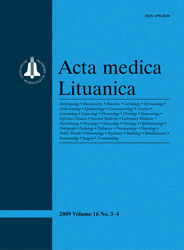 ISSN 1392-0138 ISSN 2029-4174 (online) |
2008 m. Nr. 4 Advanced non-small cell lung cancer treatment: cetuximab treatment in a randomized phase II / III trial in combination with gemcitabine or docetaxel
or with carboplatin / gemcitabine (GemTax IV). A preliminary feasibility report on the first data
Introduction. The first feasibility evaluation of the GemTax IV study using the novel therapeutic agent cetuximab, a chimaeric monoclonal antibody, which specifically targets the epidermal growth factor receptor and binds to the extracellular domain of the EGFR, preventing ligand binding and activation of the receptor was carried out. The objective was to assess the feasibility of cetuximab in combination with two common chemotherapeutic regimens in patients with locally advanced or metastatic non-small cell lung cancer. Early phase II results and updated results of the second interim analysis are presented in this article. Materials and methods. In the period 2006–2008, 328 patients were enrolled at 23 centres in Germany and 1 centre (Institute of Oncology, Vilnius University) in Lithuania. 236 patients with histologically confirmed stage IIIB or IV non-small cell lung cancer, WHO performance status 0–2, and with no prior chemotherapy received cetuximab 400 mg/m2 as an initial dose, then 250 mg/m2 weekly either in combination with gemcitabine 1000 mg/m2 on days 1 and 8 for two 3-weekly cycles followed by docetaxel 75 mg/m2 on day 1 for 2 cycles (q3w) or gemcitabine 1200 mg/m2 on days 1 and 8 and carboplatin AUC5 on day 1 for a maximum of 4 cycles (q3w). Cetuximab was administered beyond these four cycles as maintenance therapy until disease progression or unacceptable toxicity. Results. 142 patients assessable for toxicity received 404 cycles of cetuximab (1119 infusions) in combination with chemotherapy and 285 cycles (797 infusions) of single-agent cetuximab (maintenance phase). Clinically relevant toxicity is more common in the combinational treatment arm but in total not extraordinary. If therapeutic intervention was needed, there were 17 patients (14.5%) of 117 patients in Arm A and 30 patients (25.2%) of 119 patients in Arm B, respectively, resulting in a reduction to 60% of clinically relevant toxicity in Arm A in relation to Arm B. The haematological toxicities of CTC grade 3/4 indicate the treatment: the action of chemotherapy can be especially seen on day 8 and day 15. Serious adverse events (SAE’s) were officially reported, however, serious adverse events were more common in combination therapy. There were 209 SAE’s in this trial (the corresponding number of patients up to this date is 291): 98 in Arm A with some 4 duplicates: 94 SAE’s with a corresponding number of patients, 147 (study population) and 111 calls in Arm B with 2 duplicates → 109 calls with a corresponding patient number of 144 pts (study population), respectively. There were single agent cetuximab 177 cycles in arm A (33 patients), median 4 cycles per patient and mean 5.4 cycles per patient, 230 cycles in arm B (47 patients), median 3 cycles per patient and mean 4.9 cycles per patient. Overall survival is early for judgment. Conclusion. Cetuximab does not add significantly to learn chemotherapy toxicity in the induction phase and is well tolerated in the maintenance phase. Keywords: advanced non-small cell lung cancer, chemotherapy, toxicity, feasibility |
Issues:
2011 - Vol.18 No. 1, No. 2, No. 3, No. 4 2010 - Vol.17 No. 1-2, No. 3-4 2009 - Vol.16 No. 1-2, No. 3-4 2008 - Vol.15 No. 1, No. 2, No. 3, No. 4 2007 - Vol.14 No. 1, No. 2, No. 3, No. 4 2006 - Vol.13 No. 1, No. 2, No. 3, No. 4 2005 - Vol.12 No. 1, No. 2, No. 3, No. 4 2004 - Vol.11 No. 1, No. 2, No. 3, No. 4 2003 - Vol.10 No. 1, No. 2, No. 3, No. 4 2002 - Vol.9 No. 1, No. 2, No. 3, No. 4 2001 - Vol.8 No. 1, No. 2, No. 3, No. 4 |